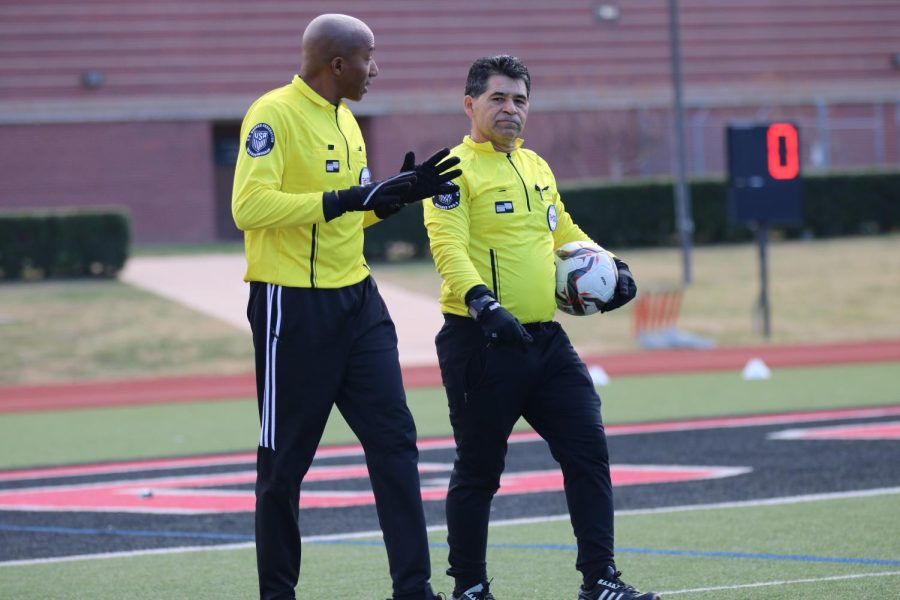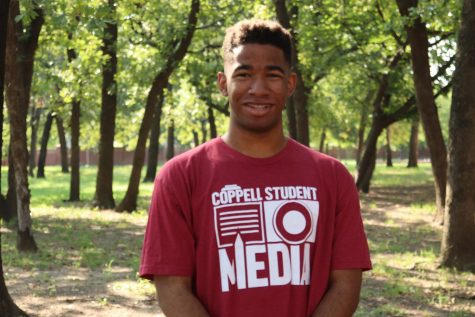Culture of referee abuse, pandemic plaguing soccer through referee shortage
Texas Association of Sports Officials referees Carmichael Willaim and David Leiva talk prior to kickoff between Coppell and San Antonio Reagan at Buddy Echols Field on Jan. 7. Due to a shortage of referees, many matches are only being officiated in duals instead of the typical trios.
January 20, 2022
Picture this.
You are a forward and you are playing in a tied match with just seconds remaining. You get a through ball played to you and make a beeline towards the goal to score the match winner.
Out of nowhere, you get clobbered from behind by the trailing defender. You go down, writhing in pain. Your teammates scream for a penalty with their hands in the air. You anticipate a whistle but there is just silence from the referees because they “didn’t see anything” and, a few seconds later, the final buzzer ends the match.
While every effect of the referee shortage may not have an outcome as dramatic, this hypothetical mirrors the reality of the high school soccer scene in this new era. The referee shortage has plagued high school soccer matches since the beginning of the pandemic and it is beginning to impact the outcomes of matches; not just in big match moments but also in smaller fouls and cardable offenses.
Prior to the pandemic, the standard was to have three referees at every match: one center referee that controls all the major calls in a match (penalties, fouls, cardable offenses and other playing infractions/violations) and two linesmen that signal offsides and aid the center referee by catching any of the former infractions that could’ve been missed.
Now, there are only two referees at every match; two referees that are some kind of hybrid between center referees and linesmen. They stand behind the line of play on both ends to call offside infractions and follow the play around from the sides of the field instead of the middle.
Across all major high school sports, referees officiating games and matches are licensed under Texas Association of Sports Officials.
“With the two referees opposed to the three referees, you miss a lot of the stuff that happens right in the middle of [the field],” TASO referee German Salvador said at the Austin Lakes Elite Showcase. “Not that you miss those calls but it’s harder when you’re vertical [on the sideline] and not in the middle.”
This back-and-forth movement on the sidelines from both referees can also impact their communication. One referee could think something in the middle of the field is a foul while the other disagrees. When the referees are focused on the play in the middle of the field and a long-ball gets switched to the other side of the field, there could be a lag between if/when they see an offside infraction and penalty actually happen. Regardless, the players and the team are negatively impacted by this lag.
“[Officiating] with just two referees on the field, you aren’t able to do quite as good of a job,” TASO referee Emily Donahue said at the Austin Lakes Elite Showcase. “You can’t be exactly in the right place to see an offside and a foul.”
But why is there a shortage of referees?
The situation is two fold: when referees are subjected to vehement amounts of abuse from fans, parents, coaches and players on a regular basis, more inexperienced referees decide that it’s not worth officiating anymore while the pandemic already has limited the number of referees willing to officiate.
Both Donahue and Salvador agree that, at times, the abuse they suffer at matches is frustrating and that they sympathize with why the newer referees decide to not return to refereeing.
“The overall culture of how we treat officials and deal with referees in this country has to change and I know that I’ve been guilty of it at times but it’s one of those things where, if we as coaches don’t set out [to] change the culture then it’s going to get worse and worse,” Coppell boys soccer coach James Balcom said.
A survey released by the National Association of Sports Officials in 2020 found that 57 percent believed sportsmanship was getting worse, a trend the respondents said was caused mostly by parents and coaches. On top of that, 70 percent of referees quit within the first three years of their careers due to the abuse.
According to Donahue, who has been refereeing for 23 years, the COVID-19 pandemic has led to a greater number of the older referees not recertifying their referee license and the outflow of newer referees has compounded the issue in the last couple of years.
“Sometimes, even when what [the coaches, fans and parents] are yelling about is right, [they need to] just understand that the way to treat humans is different,” Donahue said. “It’s not something they would do in a grocery store or on the street but you go onto a soccer field and it’s a different zone [they] go into.”
The abuse has gotten to the point where referees leave during matches. This past weekend, in the I10 Shootout in Katy, referees walked out of a match between Missouri City Ridge Point and Katy Jordan because a coach pulled out a rule book and ‘educated’ the referee on the rules during the match.
In the Austin Lakes Elite Showcase, the Coppell boys soccer team played with three referees for the first time all season and it impacted the calls Coppell were given during its three matches.
“Everyone prefers having three refs; when we see that we only have two refs, it’s kind of a little letdown and we tell each other that offsides might not be as precise as they should be and it could lead to us not scoring goals or having goals scored on us,” Coppell senior midfielder Walker Stone said. “With two refs, you can play on the shoulder [roughly] more. I could be a yard offside but they can’t see it, so it definitely comes into our brains when we’re playing. You have to be aware that it might be offside but it might not be called because they might not see it so you have to keep playing anyway.”
From a strategic standpoint inside of the players’ heads, playing with two referees is different from playing with three referees. Because the offsides calls are less precise than usual, defenders have to work harder to ensure that there is a clear and obvious offsides infraction while an attacker can break through the defensive line and get a yard ahead of the defenders.
The difference in having two referees or having three referees can also change the way you coach the match as well.
“I know some coaches will be really bothered by it but [not having an extra referee is] usually the last thing on my mind until it affects you; whether it’s two or three [referees], you’ll make do, players are going to play, [match] is going to flow but when it does start to affect the [match] and you have a goal called back, then that’s when you start to pay attention to [the lack of referees],” Balcom said.
The Cowboys haven’t been the only ones plagued by inconsistent refereeing. At Colleyville Heritage’s Allison Horn Memorial Showcase, there were multiple occasions where the Cowgirls played with two referees in which the referees initially saw a call but after further discussion with the other referees, the call was reversed and play continued.
“With two refs, it just makes you feel like not everything is seen correctly,” Coppell senior defensive midfielder Bailey Peek said.
While the long term solutions to the pandemic are becoming less and less visible, the crucial step in the right direction will come from coaches stepping in and overriding the culture of referee abuse.
“Coaches need to do a good job of not policing but speaking to their parents ahead of time,” Balcom said. “We’ve never really heard parents yelling at our officials or saying anything to them [at Coppell] and we’ve set that culture years ago, it’s just become an expectation. Most coaches don’t ever have that meeting with their parents early on and then one parents hears another parents yelling at the officials and that’s just what is thought of as OK. Now, to be part of the crowd, people feel like that’s what they have to do so until we really set the stage and tone within our own programs, parents are just going to do whatever they want to do.”
Follow Meer (@mahfuz_meer) and @SidekickSports on Twitter.













